A pair of Carineta diardi from the collection of Richard Newfrock. From Argentina.

A pair of Carineta diardi from the collection of Richard Newfrock. From Argentina.

Quesada gigas (Olivier, 1790) Is a cicada found in the United States (Texas), Argentina, Belize, Bolivia, Brazil, Colombia, Costa Rica, Ecuador, Guatemala, Guyana, Mexico, Panama, Paraguay, Peru, Tobago, Trinidad, and Venezuela. It is the largest cicada in these locations.
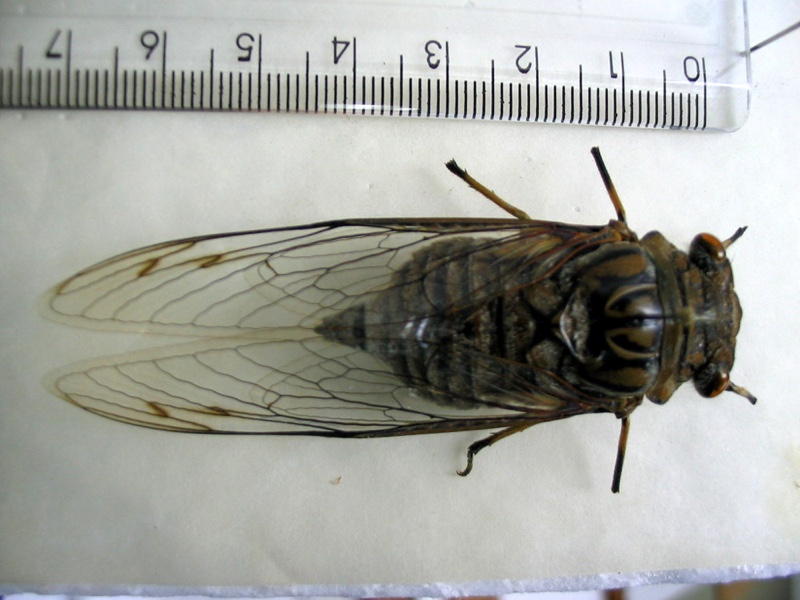
Quesada gigas from Brazil, Photo by Leonardo Milhomem.
See all Quesada gigas photos and information on cicadamania.com.
Source: ©Insect Singers | Species: Q. gigas
Playlists contain multiple videos found on YouTube.
Scientific classification:
Family: Cicadidae
Subfamily: Cicadinae
Tribe: Fidicinini
Genus: Quesada
Species: Quesada gigas (Olivier, 1790)

The image says Tympanoterpes gigas but its newest name is Quesada gigas.
Stal treated this species as a synonym of T. grossa, Fabr. The type of the Fabrician species, however, is in the Banksian collection contained in the British Museum, and is very distinct, the opercula being large and rounded.
The figure given in the Encyclopedic Methodique is, like Stal’s, useless for any practical purpose. Among the habitats of this wide-ranging species is that given by Walker 2, ” West coast of America,” which, as before remarked in connexion with other species, seems clearly to refer to Central America. The forms inhabiting this region (of which a Guatemalan specimen is figured) appear to be somewhat smaller than more southern specimens, or do not exhibit the gigantic specimens which are frequently and commonly received from the southern portion of the Neotropical Region.
Mr. Gervase F. Mathew (Ent. Mo. Mag. xi. p. 175) gives some interesting details relating to this insect as observed at Tobago. As regards its powers of stridulation he writes of a ” tropical afternoon: ” — ” Suddenly, from right above, you hear one or two hoarse, monotonous cries something like the croak of a tree-frog, and, looking upwards, wonder what it can be. But wait a moment ; this is merely a signal ; for the next minute everywhere above and around you these croaks are repeated in rapid and increasing succession until they merge into a long shrill whistle almost exactly similar to the whistle of a first-rate locomotive ; this continues for nearly half a minute, and then abruptly terminates.” ” Presently similar cries will be heard in the far distance, as if in reply to those which have just died away overhead. The whistling pierces one’s ears to such a degree that its vibrations can be felt long after it has ceased.”
Mr. Mathew describes this species as frequenting trees growing in ravines where the soil is generally soft and damp, in which their larvae and pupae find no difficulty in burrowing. ” When the latter are full-grown and ready for their last transformation, they emerge from the ground and crawl about four or five feet up the trunk of a tree, when they firmly fix themselves to the bark by means of their powerfully hooked fore tibiae.” ” The flight of the mature Cicada is abrupt, rapid, and by no means graceful ; and it does not appear to have the power of controlling itself when on the wing ; for I have often seen it fly in an insane manner against the trunk of a tree, a branch, or any other object that might be in its line of flight; and when it has performed its journey without any accident, it alights abruptly and awkwardly. As a rule, however, it does not attempt to fly to any great distance at a time.”
The Giant Cicada / Chicharra Grande page on the Texas Entomology websites is a very good resource, particularly in relation to the state of Texas.
Tympanoterpes cordubensis Berg, 1884 is a cicada found in Argentina.
Scientific classification:
Family: Cicadidae
Subfamily: Cicadinae
Tribe: Fidicinini
SubTribe: Guyalnina
Genus: Tympanoterpes
Species: Tympanoterpes cordubensis Berg, 1884
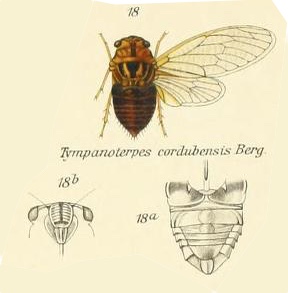
Tympanoterpes genus description by W. L. Distant:
Characters. — Head (including eyes) about equal in width to base of mesonotum, eyes scarcely projecting beyond anterior angles of pronotum, vertex of head at area of ocelli often only very slightly longer than front ; pronotum shorter than mesonotum, the posterior angles a little prominent but not lobately produced; abdomen about as long as space between apex of head and base of cruciform elevation; metasternum with a moderately elevated transverse central plate, which is not anteriorly angularly produced; tegmina usually less than about three times as long as broad, the transverse vein at base of second apical area strongly oblique ; wings about half the length of tegmina which have eight apical areas and the basal cell longer than broad.
There are far more species in South America than you’ll find on this page, but these are among the most well known.

Carineta diardi photo by Pia Öberg taken in Brazil.
More about the Carineta genus, and Carinetini tribe.
More about the Chonosia genus, and Tettigadini tribe.
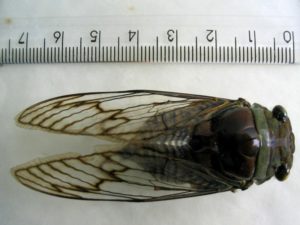
Fidicina mannifera from Brazil, Photo by Leonardo Milhomem.
More about the Fidicina genus, and Fidicinini tribe.

More about the Hemisciera genus, and Piccinini tribe.

Majeorona aper from Brazil, Photo by Leonardo Milhomem.
More about the Majeorona genus, and Fidicinini tribe.

Quesada gigas from Brazil, Photo by Leonardo Milhomem.
More about the Quesada genus, and Hyantiini tribe.

Zammara smaragdina Walker, 1850.
More about the Zammara genus, and Zammarini tribe.

More about the Tettigades genus, and Tettigadini tribe.
If you’re researching Cicadas in the Neotropic ecozone, which is Central and South America, here are some resources that will help you:
1) Follow Andreas Kay’s Flickr feed. He posts many excellent cicada photos from Ecuador. Many cicadas found in Ecuador are not endemic, so the cicadas you see in Andreas’ Flickr feed should be found in adjacent countries.
2) Visit Cigarras do Brasil – Brazilian Cicadas for photos and information about the cicadas of Brazil.
3) Read Jacobi (1907) “Homoptera Andina”. (Not sure where to find it – maybe eBay).
4) Read: Insecta. Rhynchota. Hemiptera-Homoptera. Volume I (1881-1905) by W. L. Distant and W. W. Fowler. It is available online. Here is a sample from that book:
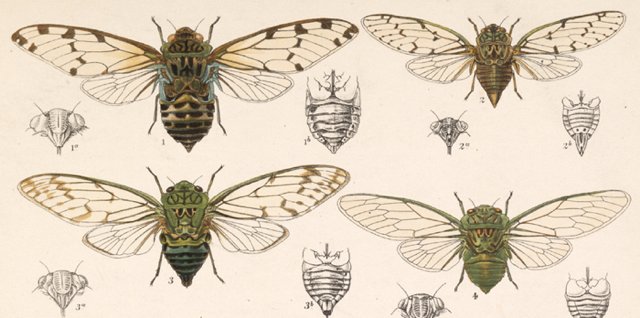
5) Search for papers written by Allen F. Sanborn. Here is how to search for cicada research papers online.
6) Use ITIS to traverse cicada species names and get listings of papers about the cicada — then search for the cicada names and papers.
7) Many photos and sound files of Paraguayan cicadas.
Thanks again to David Emery!
Click the images for larger versions, the species name and the name of the photographer.
Allen F. Sanborn & Maxine S. Heath published a new paper about cicadas titled The cicadas of Argentina with new records, a new genus and fifteen new species (Hemiptera: Cicadoidea: Cicadidae) in Zootaxa Vol 3883, No 1, in November of 2014. Website for the document.
The abstract of the paper reveals some exciting discoveries:
The document is 94 pages long.
Pia Öberg from Sweden took this cicada photo back in 2004 at Hotel do Ypê in Itatiaia NP in Brazil. Thanks to Roy Troutman and cicada expert Allen Sanborn we were able to ID this pretty cicada as a Carineta diardi (Guérin-Méneville, 1829). In addition to Brazil, C. diardi is also found in Argentina.
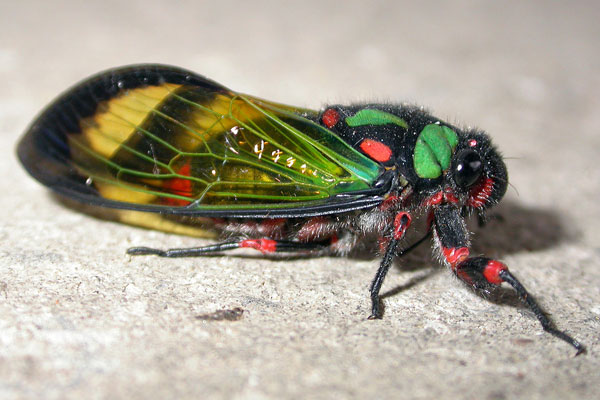
Scientific classification:
Family: Cicadidae
Subfamily: Cicadettinae
Tribe: Carinetini
SubTribe: Carinetiina
Genus: Carineta
Species: Carineta diardi (Guérin-Méneville, 1829)
Some more links for you:
More of Pia’s photos on Flickr.
What a fun way to start the New Year. Happy New Year cicada maniacs!